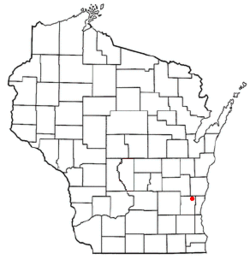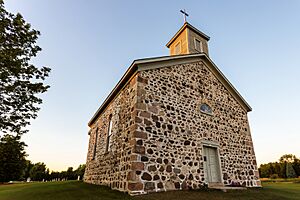Farmington, Washington County, Wisconsin facts for kids
Quick facts for kids
Farmington, Wisconsin
|
|
|---|---|

Town hall along WIS 28 in Boltonville
|
|

Location of Farmington, Washington County, Wisconsin
|
|
| Country | |
| State | |
| County | Washington |
| Incorporated | February 11, 1847 |
| Area | |
| • Total | 36.7 sq mi (95.0 km2) |
| • Land | 36.4 sq mi (94.2 km2) |
| • Water | 0.3 sq mi (0.8 km2) |
| Elevation | 896 ft (273 m) |
| Population
(2000)
|
|
| • Total | 3,239 |
| • Density | 89.0/sq mi (34.4/km2) |
| Time zone | UTC-6 (Central (CST)) |
| • Summer (DST) | UTC-5 (CDT) |
| Area code(s) | 262 |
| FIPS code | 55-25375 |
| GNIS feature ID | 1583193 |
Farmington is a town in Washington County, Wisconsin, United States. In 2000, about 3,239 people lived there. Several small communities are part of Farmington. These include Boltonville, Cheeseville, Fillmore, and Orchard Grove. Part of Saint Michaels is also in the town.
Contents
Geography and Landforms
Farmington is in the Kettle Moraine area of Wisconsin. This region has cool landforms made by a huge glacier. This massive ice sheet covered much of Canada and the northern U.S. a long time ago. The glacier created many hills, ridges, and valleys in Farmington. It also formed lakes, rivers, and streams.
The north branch of the Milwaukee River flows through the town. Stony Creek and Wallace Creek also run here. The town has several lakes, such as Ehne Lake, Erler Lake, Green Lake, Lake Twelve, and Miller Lake. These lakes were all formed by the glaciers.
The town covers about 36.7 square miles (95.0 square kilometers). Most of this area, 36.4 square miles (94.2 square kilometers), is land. The rest, 0.3 square miles (0.8 square kilometers), is water.
History of Farmington

The first people known to live in the Farmington area were the Mound Builders. They created effigy mounds between 650 and 1300 CE. These people hunted, fished, and gathered plants for food. They made tools from bone, wood, stone, and sometimes copper. They also made pottery. They were semi-nomadic, meaning they moved around.
The Mound Builders shaped their mounds like animals, birds, and other creatures. Some mounds were round, oval, or long. Some also contained human burials. At least 47 mounds, called the Hagner Group, were once in Farmington. Some were destroyed by early settlers for farms. However, 28 mounds still exist today in Lizard Mound County Park.
In the early 1800s, Potawatomi and Menominee Native Americans lived in Farmington. The Menominee gave up their land claims to the U.S. government in 1831. The Potawatomi did the same in 1833. This meant they had to leave Wisconsin by 1838. Many Native people moved west. But some stayed and lived on their ancestral lands. Later, these Native Americans gathered in northern Wisconsin. They formed the Forest County Potawatomi Community.
Farmington was part of the Town of West Bend until 1847. On February 11, 1847, it became the Town of Clarence. Then, on March 11, 1848, it was renamed the Town of Farmington. The first settlers were mostly German and Irish immigrants.
In the early 1850s, immigrants from Saxony (a region in Germany) started the community of Fillmore. They named it after President Millard Fillmore. Fillmore was home to the Saxonia House brewery, built in 1855. It was a popular meeting spot. In 1862, some Saxon immigrants started a German cultural group called the Farmington Turnverein. They built the Fillmore Turner Hall in 1868, which is still standing today.
In 1854, Harlow Bolton founded the Boltonville settlement. It was built on Stony Creek. Early settlers used the creek to power mills for grinding grain and cutting wood. Boltonville also had a cheese factory, shops, a post office, and a school.
During the 1800s and 1900s, dairy farming was very important in Farmington. Many cheese factories were built. This included a factory in Orchard Grove in 1871 and one in Cheeseville in 1881.
Farmington's population grew a lot in the late 1900s and early 2000s. Farming is still a big part of the town's economy. About 60% of the land is used for farming.
Historic Places to Visit
Farmington has four places listed on the National Register of Historic Places. These are important sites that tell us about the past:
- Lizard Mound County Park: This park has 28 well-preserved effigy mounds. These mounds were built by Native Americans long ago. They include a 250-foot lizard mound, and mounds shaped like panthers and birds. There are also smaller round and long mounds.
- Saxonia House: Built in 1855, this building was an inn and brewery in Fillmore. It was built in a traditional German style. It also has an old brewery cave from 1860. This cave was used to store beer.
- St. John of God Roman Catholic Church, Convent, and School: This church was built near Boltonville in 1891. It served mostly Irish families. The site also has a cemetery and the ruins of a convent and school from 1868.
- St. Peter's Church: German Catholic farmers built this church in 1861 using local stones. They also built a school nearby in 1874.
Parks and Recreation
Farmington offers several parks for outdoor fun:
- Leonard J. Yahr County Park: This park used to be the site of a sawmill and a match factory. Today, it has hiking trails. It also has a public beach on the shore of Erler Lake.
- Lizard Mound County Park: This park has a walking trail. You can explore a collection of 28 earthen mounds. These mounds are shaped like animals and geometric forms. Native Americans built them between 1,000 and 1,500 years ago.
See also
 In Spanish: Farmington (condado de Washington, Wisconsin) para niños
In Spanish: Farmington (condado de Washington, Wisconsin) para niños


